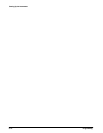
Command Syntax
Programming
3 --- 10
The argument of a command may be in one of several forms. The individual
descriptions of each command tell which argument types to use with that
command.
Block Arguments
One OA 5000 command utilizes a block argument form:
Symbol Meaning
<Block>
A block of data bytes, defined below
<NZDig> A non-zero digit character, in the range 1 --- 9
<Dig> A digit character, in the range 0 --- 9
<DChar> A character with the binary equivalent of 0 through
FF hexadecimal (0 through 255 decimal)
The block argument is in the following format:
H <Block> ::= #<NZDig><Dig>[<Dig>. . .][<DChar>. . .]
<NZDig> specifies the number of <Dig> elements that follow. Taken togeth-
er, the <Dig> elements form a decimal integer that specifies how many
<DChar> elements follow.
BLRN #222(binary data - 22 bytes)
Block Header
Specifies Number of
Length Digits that Follow
Specifies Data Length
Block Argument
Figure 3-4: Block Argument Example
The block argument can also take the following format:
H <Block> ::= #0[<DChar>. . .]<EOI>
Under IEEE Std 488.2 this is also a valid form for block arguments. If this
form is used, the last byte of the block must have EOI asserted. Conse-
quently, this must be the last or only command. Although the OA 5000
accepts this format, it will never respond to a query with this format.
Numeric Arguments
Many OA 5000 commands require numeric arguments. This manual repre-
sents these arguments as follows:
Argument Types


















